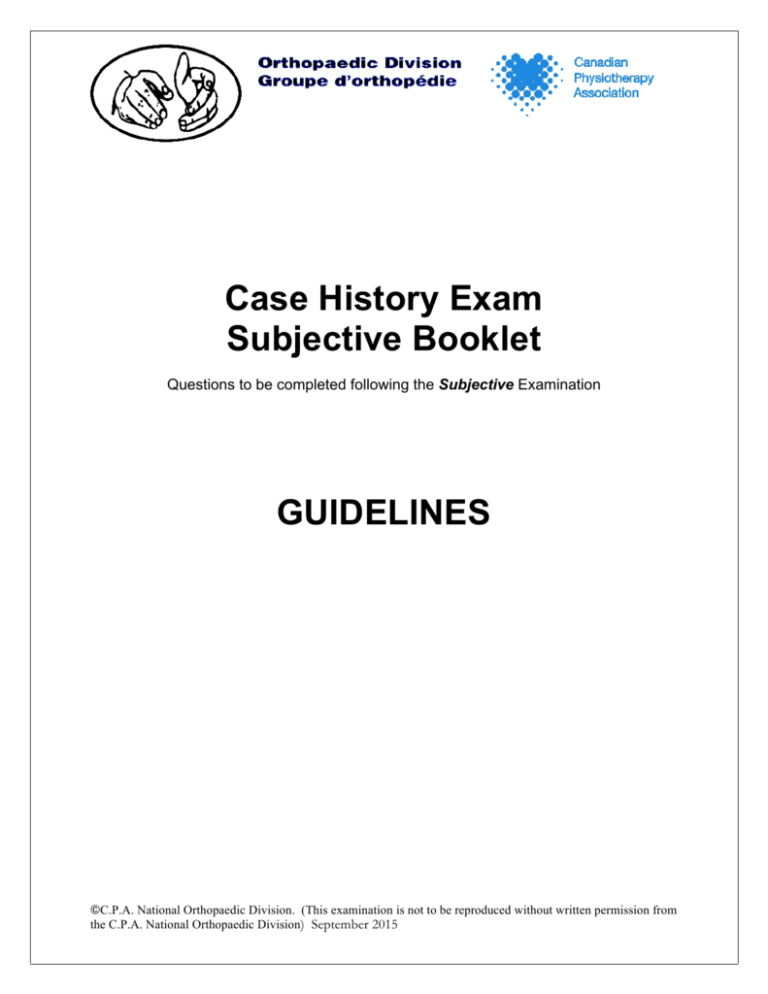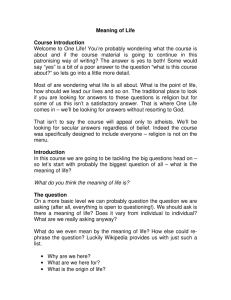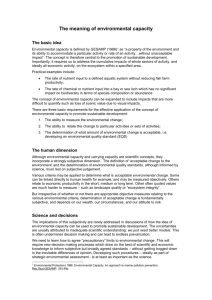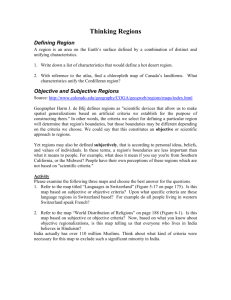Final Subjective Case History Guidelines, Sept 8, 2015
advertisement

Case History Exam Subjective Booklet Questions to be completed following the Subjective Examination GUIDELINES ©C.P.A. National Orthopaedic Division. (This examination is not to be reproduced without written permission from the C.P.A. National Orthopaedic Division) September 2015 GUIDELINES 1. The table below presents different mechanisms that may be influencing the patient’s pain presentation. Based on the information provided in the subjective examination, list the evidence, if any, that would be most indicative of each of the three categories of influences on the patient’s pain presentation. In formulating your answer, consider all 3 pain areas. (8 marks) Nociceptive General Features Mechanical Inflammatory Peripheral Neuropathic Central Neuropathic Case History Exam Subjective Booklet September 2015 Page 2 of 12 GUIDELINES GUIDELINES A good answer will include the most relevant subjective data under each of the three categories of influences that impact on a patient’s pain presentation. Nociceptive: this category of influence includes subjective data pertaining to nociceptive triggers that occurs with damaged or diseased tissue. Typically, pain originating from damaged or diseased tissue is associated with a strong stimulusresponse relationship; that is, there are clear aggravating and easing factors associated with the pain described. Although not all nociceptive pain possess the following characteristics, the following are some of the key indicators of pain originating from nociceptive sources: - - Pain description: achy or dull, sometimes sharp or stabbing with aggravating movements, depending on the type of tissue at fault. Pain location: may be fairly localized. Local area of injury may be sensitive to pressure (primary hyperalgesia) Pain behaviour: tends to behave in predictable ways. For example, pain may be associated with other signs of mechanical dysfunction, such as crepitus, popping or edema; pain is more likely to be aggravated with movement in one or more directions in a predictable fashion; that is, the magnitude of increase in pain is consistent across repeated movements (or may decrease depending on the structure(s) affected). There should also be a position or movement that does not increase the pain, and may actually decrease it. Pain that is nociceptive in origin is most likely to be present in the acute stage of injury. As the stimulus causing the pain subsides (ie. inflammation, tissue healing), the pain should also subside. Pain may radiate but should not radiate into typical dermatomal or cutaneous patterns. Nociceptive pain can also be sub-divided into ‘mechanical’ presentation and ‘inflammatory’ presentation: Mechanical sources of pain are characterized by subjective data that suggests the presence of mechanical deformation of normal and/or diseased tissue. For example, there may be clear aggravating and/or easing factors that pertain to shortand long-term deformation of tissue due to stretching and/or compression Inflammatory sources of pain are characterized by subjective data that suggests the presence of chemical irritation/stimulus due to the presence of inflammation. For example, symptoms may be aggravated after a prolonged period of relative rest. Peripheral neuropathic: This category of influence pertains to subjective data that suggest damage or disease to the peripheral nervous system. In the absence of frank nerve trauma, this type of pain is more likely to occur after the pain has been present for some time (ie: subacute/chronic). Although not all peripheral neuropathic pain possess the following characteristics, the following are some of the key indicators of this type of pain: Case History Exam Subjective Booklet September 2015 Page 3 of 12 GUIDELINES GUIDELINES - - - Pain description: Symptoms may suggest the presence of adverse neural dynamics, especially with simultaneous compression over peripheral nerves. Patients may report paraesthesia (with or without pain). Pain may be described as a deep ache, burning, crawling, electric shock, tingling, shooting, piercing, nagging. Pain location: Pain may be more localized to a particular sensory innervation of the affected nerve (ie. dermatome, peripheral nerve). This may include pain along the path of the nerve (ie. causalgia), or pain in the dermatomal area of innervation if a nerve root is the injured tissue. Pain behaviour: o Pain can be evoked by touch, stretch, pressure and/or movement, and may linger once aggravated. Pain behaviour may be similar to that of mechanical nociceptive pain. For example, pain may be elicited if stretched or compressed. o Pain can also occur spontaneously; therefore, patients may report that the pain can change (improve or worsen) without movement and/or activity. o Pain may not be responsive to conventional anti-inflammatory therapies, and may require anti-convulsants and anti-depressants. Central neuropathic: this category of influence pertains to subjective data that indicates dysfunction, injury or disease to the central nervous system. Although not all central neuropathic pain possess the following characteristics, the following are some of the key indicators of this type of pain: - - Pain description: pain is often described as diffuse. It may also be described as burning, stabbing, sharp, shooting. Patients may also report areas of sensory disturbance such as a sensation of reduced temperature. Pain location: Pain is typically not localized to a dermatome or peripheral nerve. The pain is more likely to spread to other unaffected body parts - this may manifest as sensitivity to cold or pressure stimuli beyond the borders of the original injury (secondary hyperalgesia), pain in the same part on the contralateral side (mirror pain), or sensitivity in areas completely remote from the area of symptoms (widespread hypersensitivity). The patient may have difficulty identifying the affected body part, which may manifest as difficulty drawing the part, difficulty with mental manipulation of the body part (ie. hand laterality), or stating that the body part feels somehow outside or disconnected from themselves. Pain behaviour: There is a lack of a clear stimulus-response relationship (ie. not related to activity, position, posture). The pain is more likely to be influenced by anxiety and emotional distress. Smart KM, Blake C, Staines A, Doody C. Clinical indicators of ‘nociceptive’, ‘peripheral neuropathic’ and ‘central’ mechanisms of musculoskeletal pain. A Delphi survey of expert clinicians. Manual Therapy 2010;15:80-87 Case History Exam Subjective Booklet September 2015 Page 4 of 12 GUIDELINES GUIDELINES 2 (a). List 3 of the most likely structures at fault for each area of symptoms. (4.5 marks) A good answer will identify 3 anatomical structures of differing type (e.g. muscular, articular, neurovascular, osseous, visceral) that may cause or refer symptoms to the named area (P1, P2, P3). The structures will be described by specific anatomical name and spinal levels e.g. the category paraspinal muscles is not specific enough; individual muscles should be identified i.e. splenius capitus, levator scapulae, UFT. If multiple muscles or joints or nerve roots could be pain generators, the candidate can choose to list more than one muscle or joint level, such that the plausible culprits are identified. The most likely structures are the ones that make the most sense and fit with this particular set of subjective findings. The intent of this question is to assess the candidate’s knowledge of the anatomy, musculoskeletal, neurological and vascular symptoms and their ability to accurately interpret the subjective examination data by linking them to the most likely structures at fault. P1 P2 P3 1. 1. 1. 2. 2. 2. 3. 3. 3. 2(b). For P1, explain your rationale for each of the three structures you have chosen based on the subjective data that has been provided. (3 marks) A good answer will provide a reason why each of the three anatomical structures you chose could possibly cause the symptoms described in area P1. Although one structure may appear to be the more probable cause of P1, all three structures should be possible. Key features of the onset, nature or behaviour of symptoms will be drawn from the subjective examination to support the inclusion of each structure listed as being most likely at fault for this area of symptoms. Case History Exam Subjective Booklet September 2015 Page 5 of 12 GUIDELINES GUIDELINES Structure Rationale 1. 2. 3. 3. Circle the one category that best describes the overall irritability of this patient’s condition. Justify your answer with 4 pieces of evidence from the subjective examination. (2 marks) Mild Moderate Severe “Irritability is assessed by judging 1) the vigour of activity required to provoke a patient’s symptoms, 2) the severity of those symptoms, and 3) the time it takes for the symptoms to subside once aggravated (ie. pain persistence).” “Maitland judged a patient to have irritable LBP when the pain is easily aggravated, severe, and persistent for a prolonged period of time following a cessation of the aggravating activities.” If the patient’s pain is irritable, Maitland recommended that the physical examination should be limited. (Barakatt et al 2009) A good answer will be constructed by first weighing the evidence from the subjective examination and making a judgement about the level of irritability. How do you weigh the evidence? Use the specific examples given in the subjective exam (e.g. walking distance, sitting tolerance), and compare this quantity of activity and severity of response to what you consider to be mild vs moderate vs severe. You must choose 1 of these 3 categories (mild, moderate, severe); however, the important aspect of this question is your justification. Therefore, candidates should demonstrate their clinical reasoning for their choice. What are the implications of this for the physical examination? (1 mark) This answer should reflect how the level of irritability will affect any aspects of the physical examination e.g. if there are nerve root symptoms and irritability is severe, this may affect how neural mechano-sensitivity tests are performed or in what sequence or if at all on the first visit. Barakatt ET, Romano PS, Riddle DL et al. An exploration of Maitland’s concept of pain irritability in patients with low back pain. J Man Manip Ther. 2009;17(4):196-205. Case History Exam Subjective Booklet September 2015 Page 6 of 12 GUIDELINES GUIDELINES 4. List 3 subjective examination findings that would indicate caution must be observed during the objective examination. Explain why. (3 marks) A good answer will reflect the candidate’s understanding that caution is influenced by all components in the biopsychosocial model of disability. Therefore, answers should include subjective data related to physical impairments, and psychological and social dimensions of health that would lead the candidate to observe caution during the objective examination. Although not an exhaustive list, the following are some examples: There is suspicion of more serious pathology that may be worsened by proceeding with the objective examination through physical handling (e.g. presence of a fracture, joint dislocation, large intervertebral disc protrusion). The condition and/or associated symptoms are severely irritable (symptoms easily exacerbated). A co-morbidity such as osteoporosis or cardiac disease exists which requires modification or avoidance of some positions, handling or exertion. The scenario concerns a patient with an immature skeleton or with compromised bone integrity due to age-related changes. • • • • The description of subjective examination findings alone is an insufficient answer. Candidates must also provide brief but sound justification for each subjective finding listed. The justification should demonstrate the candidates’ knowledge and understanding of how and in what manner the subjective examination findings necessitate caution. For example: • • An increasing level of symptom irritability should correspond with a decreasing vigour of the initial examination and treatment in order to avoid exacerbation of the patient’s symptoms and maintain function. Evidence of central evoked pain, psychological or social/environmental factors may indicate the need for caution in the vigour of assessment and what tests are included in the assessment, in order to avoid exacerbation of symptoms and maintain the confidence of the patient. World Health Organization (2001). International Classification of functioning, disability and health. Geneva: WHO. Case History Exam Subjective Booklet September 2015 Page 7 of 12 GUIDELINES GUIDELINES 5. Write two subjective questions you would like to have added to this case to help rule in or out any possible psychosocial (yellow), occupational (blue/black) and /or prognostic (pink) flags. Provide your justification for why you are asking these questions. (3 marks) Through the formulation of 2 subjective questions, the candidate must demonstrate the ability to probe the patient for any possible psychosocial (yellow), occupational (blue/black) and/or prognostic (pink) flags. In formulating these questions, the candidate should consider to what extent each question would produce the most important information and/or prognostic indicators that are pertinent to the patient scenario. The candidates’ justification for the subjective questions selected should demonstrate the extent to which the candidates are able to incorporate a comprehensive approach to gathering subjective data that considers implications these data will have on the rest of the assessment and the management approach. Definitions: Yellow (Psychosocial factors) – these refer to psychosocial risk factors for prolonged disability e.g. anxiety, patient’s beliefs and understanding about the condition, lack of adequate coping strategies and/or social supports Blue (social and economic factors) – these refer to conditions in the workplace that may inhibit recovery e.g. poor relationships with co-workers, high work demands Black (occupational factors) – these are also used for workplace issues but refer to organizational issues, e.g. workers’ compensation issues, attitudes towards the sick worker Pink (Prognostic factors) – these refer to affirmative factors that predict a positive outcome e.g. low fear, low concern about pain, belief that pain does not equate to harm, a desire to be involved and invested in one’s recovery, expectation that activity and/or movement will eventually lead to recovery Suggested References: New Zealand Acute Low back Pain Guide: Incorporating the guide to assessing psychosocial yellow flags in acute low back pain. October 2004 edition. www.acc.co.nz Gifford LS 2005 Editorial: Now for Pink Flags! PPA News 22:3-4 Case History Exam Subjective Booklet September 2015 Page 8 of 12 GUIDELINES GUIDELINES 6. After reading the subjective data, list the 2 (most likely) clinical hypotheses and provide 3 subjective findings to support each hypothesis. (3 marks) A good answer contains 2 clinical hypotheses that are most likely (most credible) given the subjective findings for this particular case. The brief justification must include a few points from the subjective data that substantiate each hypothesis and demonstrate the clinical reasoning process of the candidate. In this question, we are assessing the candidate’s ability to accurately interpret the subjective examination data to generate relevant clinical hypotheses. Candidates are reminded that this is based only on the subjective findings and that they should not make any assumptions as to what they may find on the physical examination at this point. An example of two hypotheses for an upper quadrant case: 1. The shoulder pain (P1) may be related to shoulder impingement syndrome involving the rotator cuff indicated by the provocation of pain on identified overhead movements. The patient’s age, history of onset and pain with lying on the shoulder are also suggestive of this condition. 2. Another potential hypothesis could be a primary cervical radiculopathy, with the neck pain, shoulder and arm pain and weakness caused by irritation of the C6 spinal nerve. This level is supported by pain referral into the thumb. Neck Case History Exam Subjective Booklet September 2015 Page 9 of 12 GUIDELINES GUIDELINES postures that aggravate the symptoms are suggestive of foraminal compression (extension), or could be related to dural involvement (slump positions). 7. Based on the subjective examination you have developed two clinical hypotheses. In planning your physical examination, provide only the most relevant (at least 6 and no more than 8) tests that you would use to support or negate your hypotheses. Include your rationale for choosing each test and the expected findings. (8 marks) A good answer will include the most relevant tests that the candidate will include in their physical examination to confirm or negate their hypotheses that were generated in the previous question (which tests rule in or rule out the potential clinical hypotheses generated) and the expected findings. The answer must demonstrate the candidate’s clinical reasoning as to their choice of tests, the rationale, the expected findings and how it assists in their differential diagnosis. A complete answer should include the relevant tests that are critical to confirm or negate the hypotheses generated. It is important for the candidate to reflect back on the hypotheses generated and to ensure that the tests chosen are the most appropriate to confirm or negate the generated hypotheses. The answer must include at least 6 and no more than 8 tests. In this answer we are assessing the candidates ability to: • • • Demonstrate knowledge of the assessment principles that enable differential diagnosis of musculoskeletal, neurological, and vascular dysfunctions. This includes but is not limited to postural assessment, biomechanical assessment, selective tissue tension testing, neurodynamics, and safety/screening tests. Demonstrate knowledge of relevant examination procedures that enable differential diagnosis of musculoskeletal, neurological, and vascular dysfunctions Effectively prioritize the patient examination NOTE: those tests that are critical to assist in the confirmation or negation of BOTH hypotheses must be included to show the candidate’s ability to reason through the development of their final hypothesis. An example for the hypotheses presented in question #6 Hypotheses of shoulder impingement as compared to cervical radiculopathy 1. Active / passive range of motion of the glenohumeral joint rationale: to determine which movements reproduce the impingement pain and which movements demonstrate a lack of soft tissue flexibility that could implicate either the GH muscles or the capsule – or rule out the shoulder in the hypothesis of radiculopathy Case History Exam Subjective Booklet September 2015 Page 10 of 12 GUIDELINES GUIDELINES expected findings: limitation of internal rotation with reproduction of pain that could be posterior capsule tightness or lack of flexibility of infraspinatus; limitation of combined horizontal flexion/adduction/internal rotation with reproduction of pain; painful arc indicative more often of impingement, but can occur with cervical conditions; if radiculopathy expect minimal positive findings on shoulder ROM tests, but may have restricted motion in directions that cause dural tension. 2. Passive accessory mobility testing of the glenohumeral joint rationale: tightness of the posterior capsule may cause an anterior translation of the humeral head or tightness of the anterosuperior portion of the capsule may cause an anterior superior translation of the humeral head resulting in altered accessory glides – either could be a contributing factor for shoulder impingement expected findings: could find a decreased posterior glide at the glenohumeral joint (could be inferior, middle or superior capsule) or if anterosuperior part of the capsule is tight, passive accessory testing would reveal a decreased posteroinferior glide both with a capsular end feel; normal if it is a radiculopathy 3. Special tests for impingement – Neer’s, Hawkins-Kennedy, empty can rationale: these tests have been shown to implicate certain structures with shoulder impingement expected findings: reproduction of pain with Neer’s and Hawkin’s Kennedy and there could be weakness with the empty can (supraspinatus); weakness with radiculopathy would be fatigable and in all positions 4. Scapular muscle control assessment – scapular dyskinesia tests –repeated forward elevation with a weight observing scapular control, external rotation load test – resisted external rotation in neutral and at 30 degrees of abduction observing scapular control and positioning rationale: altered scapular muscle activity patterns and timing can contribute to shoulder impingement expected findings: early activation or hyperactivity of upper fibres of trapezius and decreased activity and late activation of middle and lower fibres of trapezius; scapular control could be an issue with cervical spine disorders, but often less well defined 5. Scapular position – 3 or 4 point palpation, measurement with an inclinometer rationale: abnormal scapular position is often a contributing factor with shoulder impingement Case History Exam Subjective Booklet September 2015 Page 11 of 12 GUIDELINES GUIDELINES expected findings: depressed, downwardly rotated scapula, increased lateral slide; scapular elevation common with radiculopathy in an attempt to unload the neural tension 6. Cervical active/passive range of motion rationale: with a cervical radiculopathy, certain movements may be limited and reproduce neck and arm pain expected findings: decreased ipsilateral rotation/side flexion/extension with active ROM – reproduction of pain; PPIVM testing – decreased combined PIVM into extension/side flexion/rotation; PAVM testing - decreased inferomedialposterior glide (IMP) with spasm end feel; could also find decreased combined flexion/side flexion/rotation away from the affected side with a capsular end feel on PPIVM and decreased superoanterolateral glide (SAL) on PAVM testing Note: PIVM/PAVM testing could be listed as a separate test group 7. Wainner’s cluster of tests – for cervical radiculopathy – rotation range of the cervical spine, Spurling’s test, Distraction test and ULNT (median nerve bias) rationale: if 3 of the 4 variables are positive, there is a high likelihood of a cervical radiculopathy expected findings: decreased rotation (< 60degrees), reproduction of pain/symptoms with Spurling’s test (foraminal compression), relief with distraction test, positive ULNT (median nerve bias) for pain and limitation of movement; these would be negative with impingement 8. Neurological Conduction – reflexes, sensation and key muscle testing rationale: compression of the nerve root may affect the conduction expected findings: altered sensation over the affected nerve root distribution (C5 or C6), potential fatigable weakness of the C5 or C6 key muscles (biceps, wrist extensors, shoulder external rotators, deltoid) and loss or hyporeflexive deep tendon reflex of the affected nerve root (biceps, brachioradialis) Case History Exam Subjective Booklet September 2015 Page 12 of 12 GUIDELINES






